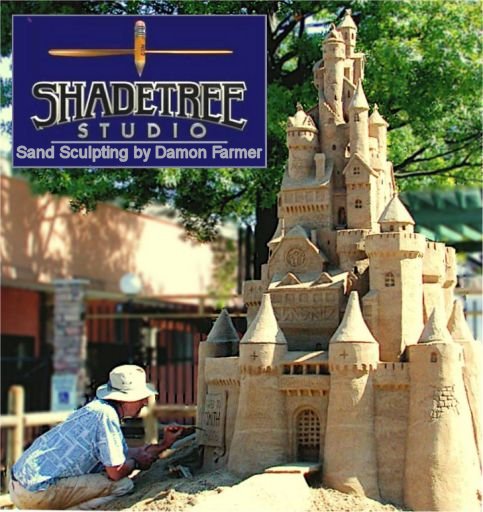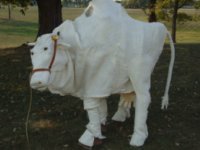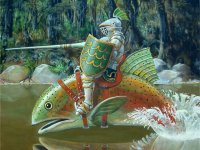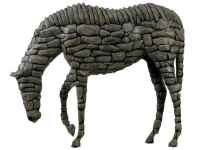Shadetree Studio is located at
30 Fintville Road
Versailles, KY 40383.
You can, of course,  shadetreestudio@aol.com shadetreestudio@aol.com
and Damon will get back to you
or you can call him at 859-873-3276
between 8:00am and 11:00 pm Eastern Time.
|
1. Sand sculptures are held together by the water in the sand. The water's surface tension between individual wet grains creates a strong bond. The bond is even stronger if the sand is compacted because the grains are closer together, so the water connection bridges a shorter gap.
|
2. Rain is much less damaging to sand sculptures then most people expect. Since water is the bonding agent, it can actually be good for the sculpture if it is otherwise too dry. Dryness is a bigger danger. For this reason, a light solution of nontoxic, invisible, biodegradable glue is often used to protect the surface from the drying effects of sun and wind. The glue gives no structural strength, but does protect the surface details.
|
3. The quality of the sand used determines in large part how long a sculpture will stand, but even poor sand can last several days without collapsing. The best sand can last indefinitely, especially if it's been coated with glue, to retard drying, or if it's located in an interior space.
|
4. No more so than when a song ends. For a sculptor, the process of sculpting is more important then the end result. A fallen sculpture just creates the opportunity to do more, and better, sculpting. I am disappointed if something collapses before I can take a photo, but that's a very rare thing.
|
5. Not really. Moving a sand sculpture is almost impossible. Even a small carving can weigh several hundred pounds, and is, of course, very delicate. Part of the charm of the art form is that they are to be enjoyed where they are, and for the limited time that they last, by the people lucky enough to be there to see them.
|
6. In my case, since January, 1975. It was during my first adult visit to a beach. I was an art student at the time and had gone to Florida for the month of January to paint landscapes, since the winter weather in Kentucky made outdoor painting difficult. I soon discovered the joy and creative potential of shaping sand and have been hooked ever since.
|
7. I have sculpted in many materials, wood, marble, clay, etc, but sand is by far my favorite. The immediacy of the image and the lack of distance between the idea and the shaping of the form make it the most appealing.
|
8. Although sand sculpture goes very fast compared to any other type of deductive sculpting (stone or wood for example) it still takes a few hours to make a substantial piece. On a day at the beach, I might easily spend six or eight hours creating a sculpture. The amount of detail effects the time necessary too, of course. As a rough example, a ten ton detailed castle, ten feet tall, would take about three days to carve.
|
9. No. Every sculpture I create is an original work, designed especially for the client or the occasion. the closest I get to repeating a piece is to do a different variation on the same theme, and even those tend to be separated by a few years of pondering how the treatment of that theme might be developed into a stronger piece.
|
10. Possibly. Sand sculpting attracts so much media attention that I have been on TV and in the newspapers many times, mainly on TV stations local to the site of the sculpture, but also sometimes on national TV and publications.
All images and content on this website © Copyright 2008 Shadetree Studio and may not be used without permission
|
THINGS TO ASK BEFORE HIRING A SAND SCULPTOR
(and the answers I would give)
Do you have a lot of experience?
I have been sculpting sand since 1975, working professionally and competing at a masters level since 1988. I have worked with most of the major sand sculpting companies, at locations in Europe, North America and Asia. I also compete at events worldwide and have been the World Champion, American Champion and North American champion. These titles were all won in the solo category, meaning no one else contributed to the sculpting.
Do you have a background in art?
I have a bachelors degree in art from Berea College, in Kentucky, and have been a full-time professional artist since 1978. Although there are many people working as sand sculptors who don't have a formal artistic background, I am convinced that the sculpture I make is enhanced by my education and artistic experience.
Were the samples I've seen created by the same artist who will sculpt my project?
In my case, absolutely yes. If you hire me, you get me. You'll be hiring a sculptor, not a sculpting company. I will be the only or primary sculptor, and I'll be the one who answers the phone when you call. However, if you hire a sandsculpting 'company' then the sculptor they send you will not necessarily be anyone whose work you've seen in their brochure or even anyone with very much experience at all. Sand Scupture companies typically have a list of sculptors they call on for jobs, and because they are the most expensive for the company, the best and most experienced sculptors don't necessarily get called first.
Is sand sculpture all you do?
I'm happy to say no to that one. I believe that working in multiple mediums improves an artists work and attitude both. What's learned in one medium enhances the others, and the dreaded burnout is avoided. Because I only do it about half the year, working in sand is always fresh to me, and I think my sculptures reflect that. Working in sand full-time also means being on the road full-time, which is a very difficult and draining lifestyle.
Do you mind answering viewers questions?
Sand sculpture is a performance art. People love watching and enjoy interacting with the sculptor. Not all sculptors are comfortable or tolerant with that, and you'll recognize those sculptors by their use of personal music systems with headphones. I understand that being accessible to the viewers is a basic part of what will make your project a success. I enjoy talking to fans of all ages, chatting and answering questions as I sculpt. For me, it is part of the joy and sharing of the art form.
Will I know what the sculpture will look like?
Yes, if that's what you want. I always talk to my clients about what they'd like to see and what would work the best visually for their project. I then provide scale drawings of the proposed sculpture from all angles. I then make every effort to have the finished piece look even better than those drawings. Some clients just ask me to "do my best work", which is certainly fine with me also.
Can I talk to some of your past clients?
Of course. References available upon request, as they say.
Here's a quote from the event organizer of a recent project for the United Way in Louisville:
"You were a very vital part of the celebration and the media coverage showed that. I hope we can work together in the future."
All images and content on this website © Copyright 2008 Shadetree Studio and may not be used without permission
|
Shadetree Studio
Glossary of Sand Sculpting Terms
This is more for the benefit of clients and newbies, but if you're a sculptor and would like to contribute a term that I've overlooked, please send it in
A View. The viewing position from which a sand sculture looks best, usually by design, sometimes by accident. It's the side where most of the photos are taken. In a contest, it is the result of focusing efforts on the side which will be most prominent to judges and audiences.
B View. The viewing position from which a sand sculpture looks the worst. The opposite of A View.
Backfill. v. Shoveling sand around the base of a sculpture, filling an area where the sand has previously been removed, to prevent an imminent collapse. Sometimes quickly done after cracks appear in the sculpture and sometimes because the sculptor deems the sculpture to be dangerously close to collapse, based on their evaluation of the sand quality.
Bird Wire. Small wires stuck into the topmost elements of a scupture and protruding several inches vertically, to discourage birds from landing and doing damage. These 'mysterious' wires are often given creative explanations to the inquiring public, especially after the first few dozen inquiries. Sample: "Those wires induce an electromagnetic field that binds the sand grains together and prevents collapse. "
Block. Carving the rough, approximate desired shape out of the pounded up sand is called 'blocking out'. It's usually done with larger trowels, or even shovels. The trick is to leave enough sand so that the exact, refined shape of the subject can be found inside the blocked out area.
BlowOut. Severe water leakage from a form during poundup, or at worse, the failure of a form during poundup, usually by having the nails holding to joined forms pull apart from pressure.
Bucket Form. Any bucket transformed into a form by cutting out its bottom, so it can be turned upside down and filled through that opening. These often top off a stack of larger forms.
Buttress. v. See Backfill.
Casting Tube. Any hollow, open-ended cylinder used as a small form. PVC pipe is commonly used.
Cold Join. Or Cold Joint. An area where soft sand is packed against a hardened poundup to extend the size of the pile. It is a very weak union between the hardpacked poundup sand and the added sand and is a common place for cracks and collapses to occur.
Contest Mode. Working on a sculpture as fast as possible to achieve completion in the available time. Sculptors typically are in this mode on the final day of a contest, but sculptors on commercial projects sometimes have to work in this mode to meet a deadline.
Contest Neck. You know it if you've had it. It's that muscle pain between your shoulder blades that is usually brought on by working in Contest Mode, sitting at odd angles with too few breaks, and made worse by
the stress of a competition or deadline.
Criteria. The guidelines used by judges in evaluating sand sculptures. Not all contests use criteria and even when it is used it's often ignored by judges.
Death March. An unreasonable distance sculptors are forced to walk to and from a sculpting site, and it doesn't take much distance to be unreasonable when you're exhausted, carrying heavy tools, and your underwear is wet and full of sand.
Flat Beach Start. A type of contest that does not provide either a pile of loose sand or a poundup for the contestants.
Flatwork. Relief scuplture created within a flat plane. Most commonly a sponsor's logo.
Fluff. 1. N. Loose uncompacted dry sand. 2. V. To smooth out loose uncompacted dry sand, usually by hand or rake, to complete the finished look of a sculpture.
Forms. Any material used to contain the sand during the poundup/compaction process. Not to be confused with molds.
Glue. Biodegradable, non-toxic, invisible white glue solution sometimes applied to the finished surface of exterior sculptures to prevent wind and sun erosion. The word glue is often avoided in public to prevent the audience's misperception that the sculptures are held together with glue. In reality, the glue coating holds the sculpture together in exactly the same way that the paint holds your car together.
Hand-Stack. Process for creating a sculpting block without a poundup, using very wet sand. Technique is similar to stacking many mud pies on top of each other, like a big stack of pancakes. Same as Wet-stack.
Harrison. Short for Harrison Hot Springs, British Columbia, Canada. Site of the World Championship of Sand Sculpting. Probably the largest annual international gathering of sand sculptors in the world.
Heartbreak Collapse. The severe structural failure (collapse) of a sculpture, resulting in a major loss of the sculpted elements.
Inies. Inies and Outies are the two types of interlocking wooden forms that combine in various even numbers to enable poundups of all sizes. Term refers to the position of the 2" X 4" braces on each piece of plywood. Innies always attach to outies on both ends, so all tiers on a poundup must have an even number of forms, and an equal number of innies and outies.
Jumping Jack. Generic name for the type of gas-operated pounding vibrator tool used to compact sand for large projects. Sort of like a lawn-mower engine powered pogo stick.
Judge. A person who decides who wins a sculpting contest. Always one of a group, so you would think the term would be Jury, wouldn't you?
Judging Light. Refers to the position of the sun at the time of day that judging occurs. Orienting a contest entry to be best seen in the 'judging light' is an important consideration in a monochrome art form, made visible primarily by shadows.
Kit. All the gear, tools, forms, supplies, etc. that a master sculptor must travel with.
Linear. Refers to sculpture composed of straight lines and flat planes, usually architecture, but could also be abstract elements or plaques for the placing of sponsor logos.
Maquette. Tiny preliminary version of a proposed sculpture, usually make in clay, but can be of sand or any material.
Master. 1. Term used to describe anyone with a sand sculpting skill level that makes them competitive in masters competitions. 2. Anyone who competes in Master's competitions. Although the term seems universal, there is no organization that decides who is or isn't a master.
Molds. Children's sand toys, Plastic formed into the shape of castles, fish, ets. Anything that shapes the sand to a finished state. Not to be confused with forms.
Newbie. A recent addition to the ranks of those enjoying creating sculptures in sand, especially those still distinctly on the uphill part of the learning curve.
Outies. See Inies.
Pestators. A composite of Pest and Spectator. Some people just can't seem to watch sculptors at work without making a sincere effort to be annoying.
Plan B. Alternate design for a sculpture, usually necessitated by the collapse of the original design. Plan B can also be a result of a Plan A that's overly ambitious for the available sculpting time.
Plan C. The plan a sculptor resorts to after Plan B collapses. Plan C frequently takes the form of a sea turtle.
Plastic. Refers to the plastic used by some sculptors to create forms for poundups. Above ground swimming pool siding is popularly used.
Pad. The sand base on which a poundup sits. The top surface at least is usually soaked and tamped level to sit forms on. Height ranges from a few inches to several feet.
Plot. The marked off area that defines the outside limits of a contest sculpture. All sand used must be from within the plot.
Pneumatic Particle Extraction Device. A very necessary and handy master's tool. It's a straw used to blow away small areas of loose sand from a sculpture.
Pop A Form To remove the forms comprising a tier, either by pulling the double-headed nails out of wooden forms or by removing the small C-clamps that hold the circular plastic or tarpaper forms in place. Other bracing devices are also sometimes used.
Prepound. 1. A type of competiton in which the poundups are created in advance by the organizers, so that the sculptors will have more time to sculpt. Most sculptors prefer this type of event.
Poundup. 1. v. The process of compacting wet sand in a form or forms to prepare it for sculpting . 2. n. The sculpting block created by the poundup process.
Prep. See Staging.
Pyramid. A series of forms stacked so that each tier is smaller than the one below, and also centered on it, resulting in a poundup that looks like a step pyramid. This is the most common type of poundup and is almost always the type provided by contests that build the poundups in advance for the contestants.
Rad Forms. Forms made from heavy tarpaper. A length of tarpaper is formed into a vertical cylinder, held together with small clamps. A less durable, but light and inexpensive, alternative to plastic or wood. Apparently first used by (and named for) sculptor Kirk Rademaker.
Satellite. If you hear sculptors talking about a satellite piece, maybe they're making a sculpture of Sputnik, but more likely they're talking about a small poundup that's made in addition to a major poundup, usually on the periphery of the plot.
Sculpting Block. The compacted sand of a poundup, after the forms are removed.
Shirt Nazis. Event directors who insist contestants wear the official event T-shirt during sculpting time.
Soft Sculpture. 1. A sculpture that is not created from a poundup. 2. Sculpture with an organic theme, as opposed to architecture. The meaning of this term varies with different sculptors.
Spike. A tall narrow poundup, such as might be formed for a lifesize version of a standing person.
Staging. The preparation of all hardware elements before the start of a contest. Buckets filled with water, forms preassembled at the site, tools at the ready, sunblock applied, etc. Same as Prepping.
Tabletop A sand sculpture small and light enough to be creation on a base (table). Typically a one-day sculpture of several hundred pounds and dimensions of maybe 2' by 2' by 4' tall (plus base).
Tamp. To compact the sand with a tool, either a hand tamper (steel plate on a vertical handle) or by a gas powered device. These are ususally called Jumping Jacks or Plate Compactors.
Tier. Each set of forms on a poundup comprise a tier.
Undercut. any part of a sand sculpture that extends beyond a vertical plane is said to be undercut. An example is the brim of a cap, created by 'undercutting' the top of the brim.
Volcano. Method for creating a sculpting block that involves pouring water into the hollowed out top of a conical pile, so that the water soaks in instead of running down the sides. Popular for amateurs, but seldom used by masters.
Weatherscreen. One of several code terms used to refer to the white glue solution coating that's often applied to the finished surfaces of outside sculptures, to prevent wind erosion. See 'Glue'.
Windscreen. One of several code terms used to refer to the white glue solution coating that's often applied to the finished surfaces of outside sculptures, to prevent wind erosion. See 'Glue'.
WetStack. See handpacked. It's the same thing. Wetstack is usually a verb but can be a noun.
Wood Forms. Plywood and board (usually two 2"x4"s) constuctions commonly used to create poundups. These are built into temporary wooden topless bottomless boxes. Forms are typically between two and eight feet long, but almost always a standard two feet high.
All images and content on this website © Copyright 2013 Shadetree Studio and may not be used without permission
After you've seen all you want here, these links will take you to the websites of a few of my sculptor buddies. Sometimes I work with these friends, sometimes we compete against each other, but they're all talented and have nice sites. There are also some competition/organization sites listed.
sandartist.com
Excellent new website by international sand sculptors Remy and Paul Hoggard.
sandcastlecentral.com
The website of Texas sculptress Sandy Feet. (Yes, that really is her name) An excellent place covering a broad range of sand sculptors and sculpture topics.
sandguy.com
The website of California sculptor Kirk Rademaker. A very original and creative artist. One of the stars of the Sandmasters TV show
sultansofsand.com
The website of Florida sculptor Rich Varano. A commercial site, but extensive and interesting involving a lot of talented international sculptors in projects worldwide
All images and content on this website © Copyright 2016 Shadetree Studio and may not be used without permission




